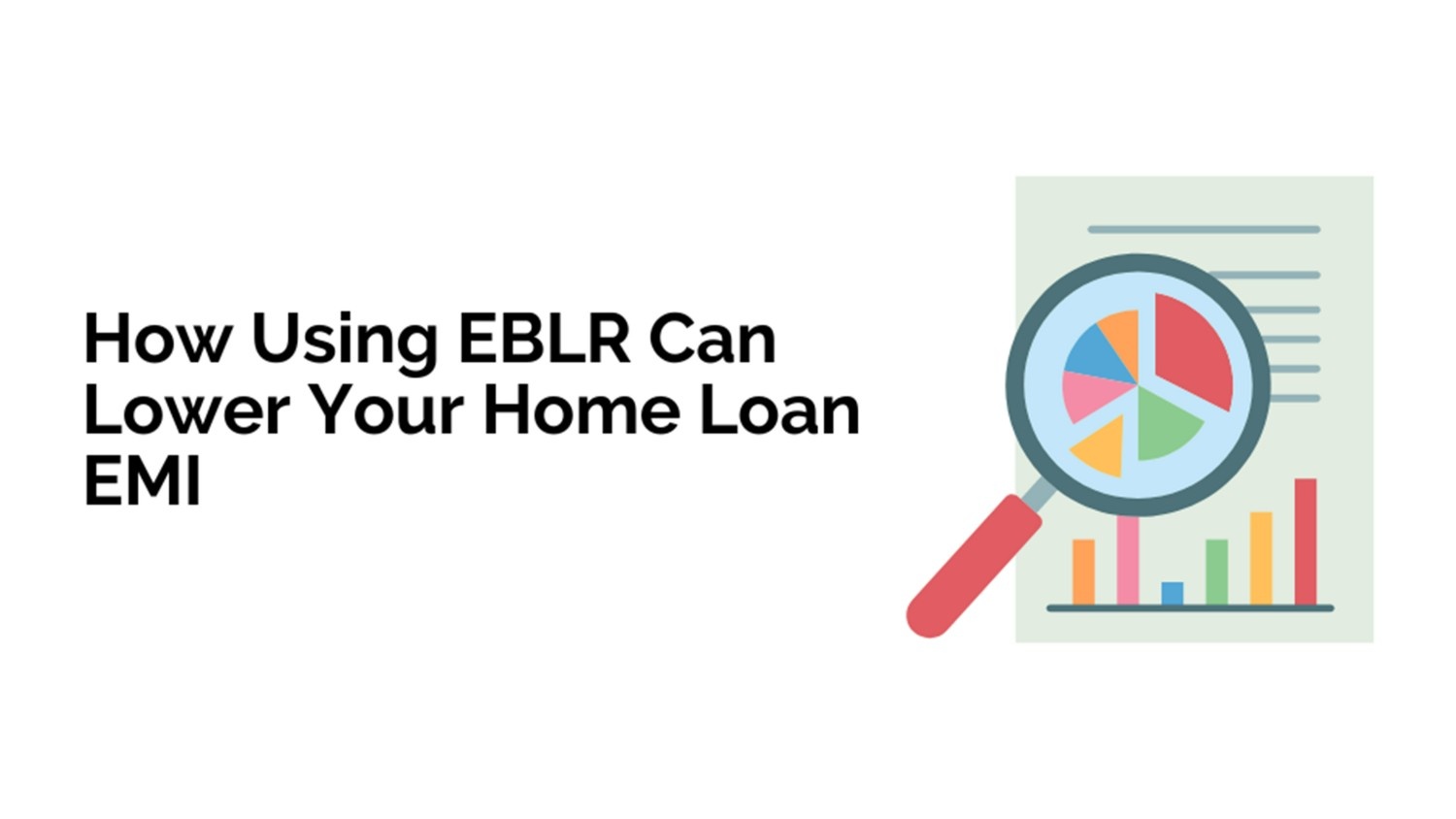How Using EBLR Can Lower Your Home Loan EMI

The Reserve Bank of India has left the policy rate unchanged at 6.50% for the sixth time in a row, dashing the hope of many loan borrowers who were expecting a rate cut and consequently, lower Home Loan rates.
Home Loan borrowers constantly scan avenues to optimize their loan terms, particularly the interest rates. A tool that has gained prominence in this regard is benchmarking the loan rate to an External Benchmark-Linked Rate (EBLR).
This rate offers numerous benefits to borrowers, ensuring their loans are more transparent and aligned with market trends.
This article looks into how Home Loan borrowers can use EBLR to their advantage, thereby making their borrowing terms more favorable and cost-effective.
What Is EBLR (External Benchmark Lending Rate)?
EBLR refers to a floating interest rate model that banks and financial institutions use to set the interest rates for loans.
Unlike the traditional internal benchmark rates, such as the Base Rate or the MCLR (Marginal Cost of funds based Lending Rate), EBLR is directly linked to an external benchmark.
Typical benchmarks include the repo rate set by the central bank, government securities yields, or any other market interest rate indicator.
The primary advantage of EBLR is its transparency and direct correlation with the broader economic conditions, ensuring that borrowers quickly gain from any reduction in lending rates.
Benefits of Benchmarking Loan Rate to EBLR
1. Enhanced Transparency
One of the foremost advantages of EBLR is the enhanced transparency it offers. Borrowers can easily track the external benchmark movements, such as the repo rate changes by the central bank, to anticipate changes in their loan interest rates. This transparency ensures no surprises, and borrowers can plan their finances more effectively.
2. Quicker Transmission of Rate Cuts
With EBLR, any reduction in the benchmark rates is quickly reflected in the borrowers’ loan interest rates. This faster transmission ensures that borrowers can benefit from lower interest payments whenever there is an easing of monetary policy, thus leading to significant savings over the loan tenure.
3. Potential for Lower Interest Rates
Benchmarking loan rates to EBLR can lead to lower interest rates than those linked to internal benchmarks. As EBLR is influenced by market conditions and central bank policies aimed at controlling inflation and stimulating economic growth, borrowers may find themselves paying less in interest during periods of rate cuts.
4. Flexibility and Competitive Advantage
EBLR provides borrowers flexibility, as they can switch between lenders offering more favorable rates linked to the external benchmark. This feature ensures that financial institutions offer the best possible rates to retain or attract customers, ultimately benefiting the borrower.
5. Better Financial Planning
The predictability and transparency associated with EBLR enable borrowers to plan their finances better. Borrowers can make informed decisions about prepayments, knowing that their loan rates will adjust in line with the external benchmark refinancing, and accordingly adjust their investment allocation
Making the Most of EBLR
To truly benefit from EBLR, borrowers should stay informed about the economic indicators and policies affecting the external benchmarks. Monitoring RBI’s announcements, economic trends, and market conditions helps borrowers anticipate changes in their loan interest rates.Additionally, borrowers should regularly review their loan agreements and consider refinancing options if a significant benefit is observed due to the interest rate movements.
Benchmarking Home Loan rates to EBLR offers many benefits, ranging from enhanced transparency and quicker rate transmission to potential savings on interest payments.
It empowers borrowers to make well-informed financial decisions and take advantage of favorable market conditions.
As financial contours evolve, adapting to such innovative benchmarking mechanisms will be crucial for borrowers seeking to optimize their loan terms and achieve financial well-being.
How EBLR Affects Home Loan Interest Rates?
Understanding how EBLR works can help you manage your Home Loan better. Here’s how the EBLR interest rate impacts your loan repayments:
-
Direct link with repo rate: The EBLR Home Loan interest rate is directly linked to an external benchmark, such as the RBI’s repo rate. So, when the RBI changes the repo rate, your interest rate also changes in the same direction.
-
Faster EMI adjustments: If the RBI reduces the repo rate, your Home Loan EMI can go down within three months. Similarly, if the repo rate increases, your EMI may increase too. The adjustment occurs more quickly than in older systems like MCLR.
-
Transparent pricing: With EBLR, the calculation of your Home Loan rate is more transparent and straightforward. It is made up of:
-
The external benchmark (like the repo rate),
-
The bank’s spread (its profit and cost),
-
And a credit risk premium (based on your credit score and profile).
-
Greater control for borrowers: Since all banks must use the same benchmark for the same loan category, you can easily compare interest rates across banks and switch lenders if needed.
EBLR helps ensure that your Home Loan interest rate responds more quickly to market changes, providing you with greater clarity and control.
Can EBLR be lower than MCLR?
The EBLR can, at times, be lower than the Marginal Cost of Funds-based Lending Rate (MCLR) for several reasons, reflecting the differences in how these rates are calculated and what they are tied to:
1. Link to Market Rates
EBLR is directly linked to external market benchmarks such as the repo rate, treasury bill rate, or other benchmarks published by Financial Benchmarks India Pvt Ltd (FBIL). These rates are generally more volatile but can be lower than the cost of funds for banks, especially in a decreasing interest rate environment. When the RBI reduces the repo rate, the EBLR can decrease more quickly than the MCLR, which is based on the banks' internal cost of funds.
2. Responsiveness to Monetary Policy
The EBLR system is designed to ensure that the transmission of monetary policy is more direct and immediate. When the central bank changes policy rates, EBLR-adjusted loans reflect these changes more quickly than MCLR-based loans. In a scenario where the central bank is lowering rates to stimulate the economy, EBLR rates can decrease more swiftly, making them lower than MCLR rates which adjust with a lag.
3. Calculation Components
The MCLR calculation includes several components such as the marginal cost of funds, operating costs, tenor premium, and negative carry on account of Cash Reserve Ratio (CRR). These components can keep the MCLR relatively high even when external benchmark rates decrease. In contrast, EBLR is more straightforwardly tied to external rates without the direct inclusion of these additional costs.
4. Market Conditions
In periods of liquidity surplus or when the central bank is pursuing an accommodative monetary policy, market-determined rates like the repo rate tend to be lower to encourage borrowing and investment. Since EBLR is tied to these rates, it naturally becomes lower than MCLR, which might not immediately reflect such market conditions due to its calculation methodology.
5. Banking Sector's Cost Structure
MCLR reflects the bank's internal cost structure, including the cost of raising new funds. If the banking sector experiences high operational costs or if the cost of deposits remains high, MCLR will not decrease as quickly as EBLR, which is less affected by these internal banking costs.
EBLR vs MCLR: Which One Should You Choose?
Here’s a quick comparison between EBLR and MCLR to help you decide what works best for your Home Loan needs:
|
Feature |
EBLR (External Benchmark Lending Rate) |
MCLR (Marginal Cost of Funds-Based Lending Rate) |
|
Benchmark Source |
Linked to external rate (like repo rate set by RBI) |
Set internally by the bank |
|
Rate Transparency |
High benchmark is public and standardised |
Low internal factors may vary from bank to bank |
|
Speed of Rate Transmission |
Fast–rate changes reflect within 3 months |
Slow – delays in passing rate cuts/changes |
|
Control for Borrower |
Easier to compare across banks |
Difficult to compare as banks use different calculations |
|
Volatility |
Higher – frequent EMI changes are possible |
More stable – but slower response to RBI rate changes |
|
Which One to Choose? |
Ideal for borrowers who want quick rate cuts and transparency |
Suitable for those preferring stable, predictable EMIs |
Conclusion
The shift to EBLR has made loan pricing more transparent and responsive to changes in RBI policy. When considering what EBLR is in Home Loan, it refers to the External Benchmark Lending Rate, an interest rate linked directly to external benchmarks like the RBI repo rate. For most new borrowers, especially homebuyers, EBLR Home Loan options provide better clarity and quicker benefits from interest rate reductions. However, if you prefer steady EMIs with fewer fluctuations, MCLR-based loans may still appeal. Always compare both options, assess your loan tenure, income stability, and risk appetite before making a choice. Whatever you pick, ensure it aligns with your long-term financial goals.
Frequently Asked Questions
1. What is EBLR in Home Loan?
EBLR stands for External Benchmark Lending Rate. It is a method used by banks to set Home Loan interest rates based on an external benchmark, like the RBI’s repo rate. This system enables faster adjustments in loan rates when the benchmark changes, providing borrowers with greater transparency and improved rate transmission compared to older methods, such as MCLR.
2. How does EBLR help reduce my Home Loan EMI?
When the RBI lowers the repo rate, your EBLR Home Loan interest rate is likely to drop automatically within a few months. This reduces the total interest on your loan, which in turn lowers your EMI (monthly instalment). So, if you're under EBLR, you benefit faster from falling interest rates than borrowers on older rate systems.
3. How is EBLR different from MCLR?
EBLR is linked to an external benchmark, such as the repo rate, while MCLR is set internally by the bank. EBLR is more transparent and reflects changes in RBI policy faster. MCLR may take longer to pass on rate cuts to borrowers. So, EBLR helps you benefit from falling interest rates quicker than MCLR.
4. Can my EMI increase under EBLR?
Yes, your EMI can increase under EBLR if the RBI raises the benchmark rate, like the repo rate. Since EBLR reacts quickly to policy changes, any increase in benchmark rates will raise your interest rate and EMI. This makes EBLR more volatile, but also more responsive compared to older loan rate systems.
5. How can I switch my existing Home Loan to EBLR?
To switch to EBLR, you must contact your bank and submit a formal request. Some paperwork may be involved, and your credit profile might be reviewed again. Many banks allow existing customers to shift from MCLR or base rate to EBLR-based Home Loans, but it's best to ask your bank for specific steps.
6. Will switching to EBLR affect my loan tenure?
Yes, switching to EBLR can affect your loan tenure. If the interest rate changes due to fluctuations in the repo rate, your EMI or loan term may change accordingly. For instance, if rates fall, your EMI may reduce or your tenure may become shorter, depending on your bank’s loan reset policy.
7. Is there a charge for switching to EBLR?
Yes, some banks may charge a nominal fee for switching your loan from MCLR or base rate to EBLR. This fee varies by lender and is usually a one-time charge. Always check with your bank about any applicable charges or administrative costs before making the switch.
8. Is EBLR better than a fixed interest rate loan?
EBLR loans offer quick benefits when interest rates fall, making them ideal in a declining rate environment. However, fixed interest rate loans provide more EMI stability. If you want predictable payments, fixed loans work well. But if you’re comfortable with some changes in EMI, EBLR could offer long-term savings.
